News Letter
Sign Up & get 33% off your first order
Enter your preferred name & e-mail to subscribe

Brass solenoid valves come is many forms, typically the most popular are the 2/2 way (2 port 2 position open/closed) or 3/2 way (3 port 2 position divert) valves.
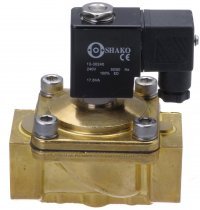 Brass 2/2 Way
Brass 2/2 WayHave 1 inlet and 1 outlet for basic ON/OFF flow control, when installed in a pipeline they will open or close to allow or stop the flow of gas or liquid media along the pipe. Except coaxial solenoid valves, typical brass 2/2 way solenoid valves can only control the flow of media in 1 direction.
2/2 way normally closed brass solenoid valves are fail-safe closed and require electrical power to open, whereas 2/2 way normally open brass solenoid valves are fail-safe open and require electrical power to close.
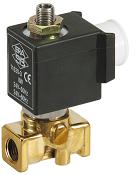 Brass 3/2 Way
Brass 3/2 WayHave typically 1 inlet and 2 outlets for basic flow diversion from inlet to either of the outlet ports. When installed in a pipeline can either be normally closed, normally open or universal function.
Normally closed - if we assume (looking at picture on Left-hand Side) inlet bottom left-hand side, outlet bottom right-hand side and exhaust through top.
De energised (no electrical power applied) inlet is closed outlet can vent up through exhaust - Energised inlet is open to outlet but exhaust is closed.
Normally Open - if we assume (looking at picture on Left-hand Side) inlet bottom left-hand side, outlet bottom right-hand side and exhaust through top. De-energised (no electrical power applied) inlet is open to outlet with exhaust closed - energised inlet is closed with outlet venting through exhaust.
Universal - if we assume (looking at picture on Left-hand Side) inlet bottom left-hand side, outlet bottom right-hand side and exhaust through top.
De-energised (no electrical power is applied) - inlet is closed outlet can flow to exhaust - energised inlet flows to outlet and exhaust is closed, however you can use any port as inlet. So effectively you can use a universal 3/2 way brass solenoid valve as normally closed (pressure to inlet port), normally open (pressure to outlet port) or diverting (pressure to exhaust port).
There are typically three types of operation for brass solenoid valves, direct acting, assisted lift and pressure assisted.
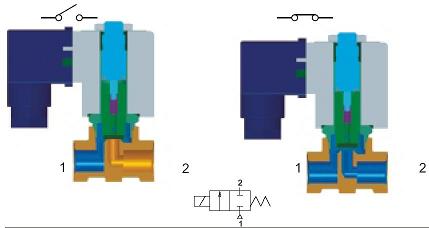 Brass Direct Acting solenoid valves-
Brass Direct Acting solenoid valves-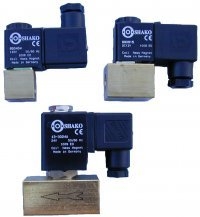
Also known as poppet or plunger type solenoid valves. When the solenoid coil is energised (electrical power is applied) the magnetic force directly pulls the armature / plunger which in itself directly controls the flow of media through the solenoid valve. When power is removed, the plunger returns to its original position, covering the orifice and stopping the flow of any gas or liquid media through the solenoid valve.
Typically used for miniature compact applications, high, low and medium pressure and vacuum systems with low flow, gravity fed, air, water, light oil and closed loop or gravity fed systems.
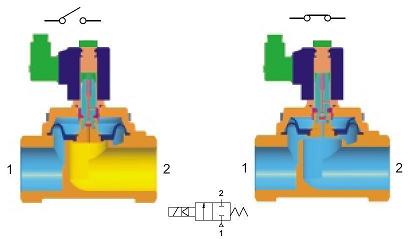 Brass assisted lift solenoid valves -
Brass assisted lift solenoid valves -Also known as hung diaphragm or kick pilot solenoid valves. When the solenoid coil is  energised (electrical power applied) the magnetic force pulls the armature / plunger which in turn lifts the diaphragm that is hung from it thus opening the solenoid valve and allowing media flow when used on low pressure or vacuum systems. On medium pressure systems to 10 bar the armature reveals a pilot hole allowing the pressure above the diaphragm to escape downstream through the outlet faster than it is replaced, so the inlet pressure forces the diaphragm upward, opening the solenoid valve to allow media flow. When the coil is de-energised the plunger is released back to its original position thus placing the diaphragm back in the closed position shutting the solenoid valve. For medium pressure applications this closes the revealed pilot hole, causing the pressure to rebuild above the diaphragm, forcing the valve closed.
energised (electrical power applied) the magnetic force pulls the armature / plunger which in turn lifts the diaphragm that is hung from it thus opening the solenoid valve and allowing media flow when used on low pressure or vacuum systems. On medium pressure systems to 10 bar the armature reveals a pilot hole allowing the pressure above the diaphragm to escape downstream through the outlet faster than it is replaced, so the inlet pressure forces the diaphragm upward, opening the solenoid valve to allow media flow. When the coil is de-energised the plunger is released back to its original position thus placing the diaphragm back in the closed position shutting the solenoid valve. For medium pressure applications this closes the revealed pilot hole, causing the pressure to rebuild above the diaphragm, forcing the valve closed.
Typically used for water control, air systems, gravity fed and closed loop systems, vacuum systems requiring good flow.
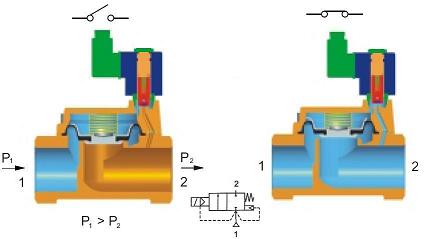 Brass pressure Assisted solenoid valves -
Brass pressure Assisted solenoid valves - 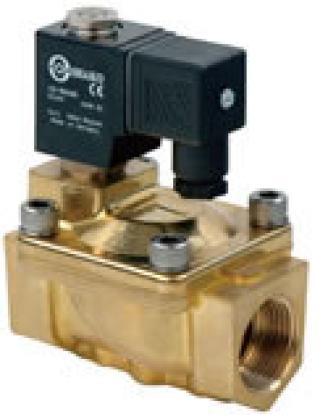
Also known as servo assisted or floating diaphragm solenoid valves. When the solenoid coil is energised (electrical power applied) the magnetic force pulls the armature / plunger which in turn reveals or opens a pilot circuit that allows the pressure above the diaphragm to escape via the outlet port faster than the pressure can be replaced from the inlet. This in turn utilises the media pressure differential (pressure difference between inlet and outlet) to move the diaphragm into the open position, allowing media to flow through the solenoid valve. The de-energised the armature returns to the rest position, closing the pilot circuit, so the media can again accumulate pressure above the diaphragm, forcing it closed.
Typically used for water, air, light oil, high pressure and open to atmosphere systems requiring good flow at a reduced cost.
Helpful Hints: 1. Always flush out the pipework system to remove and debris or contamination before installing a solenoid valve and 2. it is good practice to install a filter before the solenoid valve 3. Typically solenoid valves should be installed with the coil vertical.
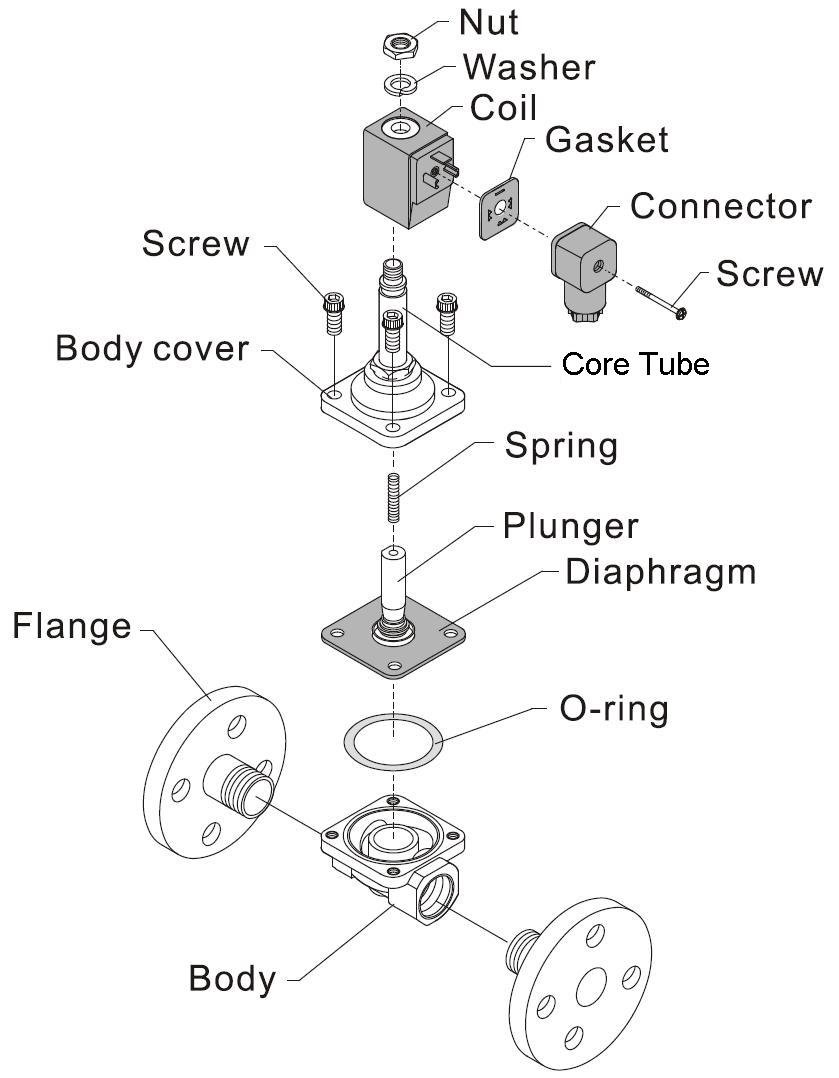 Brass solenoid valves have several materials of construction, from the brass solenoid valve body to the seals, tube, plunger, springs,elastomer seals and supports. Typically brass solenoid valves will come with a range of elastomer seals options such as NBR which has good resistance against Aliphatic Hydrocarbons, Petroleum, Fuels, Mineral Oil, Vegetable and Hydraulic Oil, Alcohol, water, air, vacuum and natural gas. EPDM which has good resistance to hot water, Ozone, Oxidising Chemicals, Fire proof hydraulic fluids most Ketone's and Alcohols,sunlight,abrasion and tearing. FKM heat resistance to 150 degrees centigrade and is commonly used for hot water,acid,alkali,oils,hydrocarbons and salt solutions, but keep in mind the limitations of the brass body.
Brass solenoid valves have several materials of construction, from the brass solenoid valve body to the seals, tube, plunger, springs,elastomer seals and supports. Typically brass solenoid valves will come with a range of elastomer seals options such as NBR which has good resistance against Aliphatic Hydrocarbons, Petroleum, Fuels, Mineral Oil, Vegetable and Hydraulic Oil, Alcohol, water, air, vacuum and natural gas. EPDM which has good resistance to hot water, Ozone, Oxidising Chemicals, Fire proof hydraulic fluids most Ketone's and Alcohols,sunlight,abrasion and tearing. FKM heat resistance to 150 degrees centigrade and is commonly used for hot water,acid,alkali,oils,hydrocarbons and salt solutions, but keep in mind the limitations of the brass body.
Typically the core tube is AISI304 stainless steel, the armature spring is AISI302 stainless steel and the armature or plunger will be magnetic 430F stainless steel which like brass does not like sea water and many aggressive chemicals.
Brass solenoid valves are typically robust in construction unlike plastic solenoid valves so they can easily be installed onto existing pipework with PTFE sealing tape or most other sealing compounds, unlike plastic which normally requires specialised sealing compounds and a more delicate engineers touch.
Brass solenoid valves can also handle higher temperatures unlike plastics which become significantly weaker as temperatures rise much above 60 C.
Brass solenoid valves are much better suited to higher pressures and shock loading as plastic solenoid valves are typically limited to 10 bar.
Brass solenoid valves are typically less expensive than Stainless steel solenoid valves.
Brass solenoid valves are good for compressed air, water, light oil, vacuum, diesel,petrol, some dilute chemicals, steam, hot water, chilled water, high or low pressure and most other general purpose systems.
A catalouge of articles covering all aspects of solenoid valves
Enter your preferred name & e-mail to subscribe